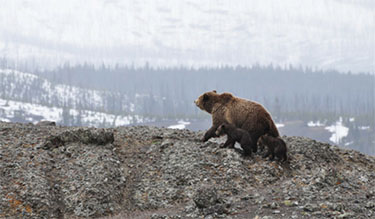Bear Safety: An Alberta Case Study

Human-bear conflict is an ongoing challenge to both conservation efforts and in the daily lives of the people who live and work in bear country. Grizzly bears attracted to human food sources can destroy private property, cause significant economic losses, and even cause public safety concerns. However, through cooperation among scientists, government agencies, NGOs and the public, human-bear conflict can be reduced, saving resources and protecting these valuable animals. This month we’re lucky enough to feature the work of Dr. Andrea Morehouse who shares the conservation challenges and practical solutions found in Southwest Alberta. The mountains meet in the prairies in southwestern Alberta. Strong winds shape the landscape and the Rocky Mountains transition rapidly to agricultural lands resulting in spectacular scenery. Grizzly Bears and other large carnivores roam the landscape. The area is part of the Crown of the Continent, home to a UNESCO Biosphere Reserve, and arguably one of the most beautiful places in Alberta. For the past nine years, I have been lucky to call southwestern Alberta home. Unlike other areas of the province with extensive protected areas and large tracts of public land, public lands in southwestern Alberta are limited. Within the 3,600 km2 grizzly bear management area (BMA 6) that extends from Highway 3 south to the border with Montana, there are only ~2,000 km2 of public land. Simply put, this is not enough space to sustain viable populations of wide-ranging large carnivores. Consequently, there is a high degree of overlap between large carnivore home ranges and private land uses. Perhaps not surprisingly, southwestern Alberta has and continues to be a hotspot of large carnivore-agricultural conflicts and bear safety continues to be an important topic. “I feel fortunate to work with a community of proactive people willing to consider a landscape shared with carnivores.” The region is home to all four native large carnivores – grizzly bears, black bears, wolves, and cougars – and it was research on large carnivores that brought me to the area. My experience in southwestern Alberta began as a M.Sc. student at the University of Alberta studying wolf diet. Subsequently I completed a Ph.D. also at the University of Alberta studying grizzly bear population ecology and large carnivore conflicts in the region. Depredation of livestock by large carnivores is a long-standing issue, and wolves are the primary culprit. Indeed, during the summer grazing season approximately 45% of wolf diet is domestic cattle. Grizzly bears also kill livestock and are responsible for the second highest number of livestock depredation events in Alberta (second to wolves). Southwestern Alberta is home to a high density of grizzly bears; resident grizzly bear density in BMA 6 is 20.4 grizzly bears/1,000 km2 in the Recovery Zone (Western public lands) and 17.1 grizzly bears/1,000 km2 in the Support Zone (Eastern private lands). Additionally, a high number (approximately 172) of grizzly bears use the area each year. Because of their omnivorous diet, grizzly bears cause more problems than just livestock depredation. Access to attractants can also be a source of conflict between people and bears. Bears can damage standing crops and stored silage and grain; destroy grain bins; raid gardens, fruit trees, and garbage; and be a human-bear safety issue when in proximity to homes and communities. Understandably, such conflicts are are a huge concern to communities that live within carnivore home ranges. What can be done to prevent negative interactions with large carnivores? It is important to understand that there is no “one size fits all” solution to the conservation challenge of mitigating human-carnivore conflicts. Solutions must be place-based and work for the individual experiencing the conflict. I feel fortunate to work within a community of proactive people that are willing to consider a shared landscape with carnivores. Building on previous work led by community groups such as the Drywood Yarrow Conservation Partnership, the Chief Mountain Landowner Initiative, and the Blackfoot Challenge in Montana, as well as collaborations with the provincial government, the Waterton Biosphere Reserve’s (WBR) Carnivores and Communities Program began in 2009 in response to increasing conflicts between large carnivores and agricultural land uses. I have been involved with the WBR since 2011 and joined their board of directors in 2014. [We] operate on a consensus-based model and together have made tremendous strides in reducing agricultural conflicts with large carnivores.” The Carnivores and Communities Program is led by the Carnivore Working Group (CWG), made up primarily of landowners and producers from Cardston County and the Municipalities of Pincher Creek, Ranchland and Willow Creek, as well as representatives from the provincial government, non-profit organizations such as the Nature Conservancy of Canada, and researchers such as myself. The CWG operates on a consensus-based model, and together this group has made tremendous strides in reducing agricultural conflicts with large carnivores in the local community. Much of the work completed by the WBR CWG to date has focussed on restricting grizzly bear access to agricultural attractants. Our evaluation of grizzly bear conflicts in the area has identified grain and dead livestock as the two most common grizzly bear attractants in southwestern Alberta. Changes to grain bins such as bear-proof grain bin doors, hopper bottom bins, and the installation of cement floors have all helped prevent grizzly bear access. Sea Cans, or shipping containers, have also been used successfully to store grain and other attractants. Additionally, electric fencing has been a powerful tool in preventing grizzly bear access to a wide variety of attractants including grain, silage, bee yards, and calving pastures. Dead stock, or boneyards, represent a major attractant not only for grizzly bears but for also for all large carnivores, potentially bringing carnivores into proximity with other attractants and agricultural land uses. The WBR’s dead stock removal program focuses on removing this attractant from the landscape through either on-farm pickup or bear proof deadstock bins where a producer can bring dead animals, thereby removing the attractant from his/her property. “Electric fencing has been a powerful tool in preventing grizzly bear access to a wide variety of attractants.”

